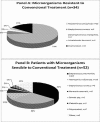Microorganisms resistant to conventional antimicrobials in acute exacerbations of chronic obstructive pulmonary disease
- PMID: 29907113
- PMCID: PMC6003174
- DOI: 10.1186/s12931-018-0820-1
Microorganisms resistant to conventional antimicrobials in acute exacerbations of chronic obstructive pulmonary disease
Abstract
Background: Antimicrobial treatment for acute exacerbations of chronic obstructive pulmonary disease (AECOPD) remains controversial. In some cases AECOPD are caused by microorganisms that are resistant to treatments recommended by guidelines. Our aims were: 1) identify the risk factors associated with infection by microorganisms resistant to conventional treatment (MRCT), 2) Compare the clinical characteristics and outcomes of patients with AECOPD resulting from MRCT against those with AECOPD from other causes.
Methods: We prospective analysed a cohort of patients admitted with severe AECOPD (2009 to 2015) who were assigned to three groups: patients with MRCT (those patients with germs resistant to antibiotics recommended in guidelines), patients with microorganisms sensitive to conventional antimicrobial treatment (MSCT), and patients with negative microbiology results who had not previously received antibiotics. Multinomial logistic regression analyses were used to examine the associations between microbial aetiology groups and risk factors. The association between LOS and risk factors was also tested in simple and multiple analyses, and similar inclusion criteria were applied for the linear regression analysis.
Results: Of the 451 patients admitted, 195 patients (43%) were included. Respiratory cultures were positive in 86(44%) and negative in 109(56%). MRCT were isolated in 34 cases (40%) and MSCT in 52 (60%). Patients with MRCT had more AECOPD in the previous year, received more antibiotic treatment in the previous three months, had more severe disease, higher dyspnoea and a positive respiratory culture in the previous year (mainly for Pseudomonas aeruginosa). The following conditions were independent factors for MRCT isolation: non-current smoker (odds ratio [OR] 4.19 [95% confidence interval [CI] 1.29-13.67], p = 0.017), ≥ 2 AECOPD or ≥ 1 admission for AECOPD in the previous year (OR 4.13 [95% CI 1.52-11.17], p = 0.005), C-reactive protein < 5 mg/dL; (OR 3.58 [95% CI 1.41-9.07], p = 0.007). Mortality rates were comparable at 30-days, one year and 3 years; however, patients in the MRCT group had longer hospital stays.
Conclusion: In conclusion, there are risk factors for resistant germs in AECOPD; however, the presence of these germs does not increase mortality. Patients with isolation of MRCT had longer length of stay.
Keywords: COPD; Exacerbation; Resistance to antimicrobials.
Conflict of interest statement
Ethics approval and consent to participate
The study protocol was approved by the Hospital Research and Ethics Committee (CEIC 2008/4106) and the study was conducted in accordance with good clinical practice guidelines and the declaration of Helsinki. Written informed consent was obtained from all enrolled patients.
Competing interests
The authors declare that they have no competing interests.
Publisher’s Note
Springer Nature remains neutral with regard to jurisdictional claims in published maps and institutional affiliations.
Figures




Similar articles
-
Pseudomonas aeruginosa resistance patterns and clinical outcomes in hospitalized exacerbations of COPD.Respirology. 2016 Oct;21(7):1235-42. doi: 10.1111/resp.12825. Epub 2016 Jun 20. Respirology. 2016. PMID: 27325555
-
Real-life data on antibiotic prescription and sputum culture diagnostics in acute exacerbations of COPD in primary care.Int J Chron Obstruct Pulmon Dis. 2017 Jan 13;12:285-290. doi: 10.2147/COPD.S120510. eCollection 2017. Int J Chron Obstruct Pulmon Dis. 2017. PMID: 28144133 Free PMC article.
-
Multiple-drug-resistant bacteria in patients with severe acute exacerbation of chronic obstructive pulmonary disease: Prevalence, risk factors, and outcome.Crit Care Med. 2006 Dec;34(12):2959-66. doi: 10.1097/01.CCM.0000245666.28867.C6. Crit Care Med. 2006. PMID: 17012911
-
Antibiotic therapy for exacerbations of chronic obstructive pulmonary disease (COPD).J Chemother. 2010 Oct;22(5):291-7. doi: 10.1179/joc.2010.22.5.291. J Chemother. 2010. PMID: 21123150 Review.
-
Pseudomonas aeruginosa in adults with chronic obstructive pulmonary disease.Curr Opin Pulm Med. 2009 Mar;15(2):138-42. doi: 10.1097/MCP.0b013e328321861a. Curr Opin Pulm Med. 2009. PMID: 19532029 Review.
Cited by
-
Development and validation a simple model for identify malignant ascites.Int J Med Sci. 2021 Mar 3;18(9):1966-1974. doi: 10.7150/ijms.53743. eCollection 2021. Int J Med Sci. 2021. PMID: 33850466 Free PMC article.
-
Reducing Hospital Readmissions in Chronic Obstructive Pulmonary Disease Patients: Current Treatments and Preventive Strategies.Medicina (Kaunas). 2025 Jan 9;61(1):97. doi: 10.3390/medicina61010097. Medicina (Kaunas). 2025. PMID: 39859079 Free PMC article. Review.
-
Trends in the Bacterial Prevalence and Antibiotic Resistance Patterns in the Acute Exacerbation of Chronic Obstructive Pulmonary Disease in Hospitalized Patients in South India.Antibiotics (Basel). 2022 Nov 9;11(11):1577. doi: 10.3390/antibiotics11111577. Antibiotics (Basel). 2022. PMID: 36358232 Free PMC article.
-
A Risk Prediction Model for Prolonged Length of Stay in Patients with Acute Exacerbations of Chronic Obstructive Pulmonary Disease: A Retrospective Study of 225 Patients in a Single Center in Kunming, China.Med Sci Monit. 2022 Feb 9;28:e934392. doi: 10.12659/MSM.934392. Med Sci Monit. 2022. PMID: 35136009 Free PMC article.
-
Prognostic risk factors for moderate-to-severe exacerbations in patients with chronic obstructive pulmonary disease: a systematic literature review.Respir Res. 2022 Aug 23;23(1):213. doi: 10.1186/s12931-022-02123-5. Respir Res. 2022. PMID: 35999538 Free PMC article.
References
-
- From the Global Strategy for the Diagnosis, Management and Prevention of COPD Global Initiative for Chronic Obstructive Lung Disease (GOLD) 2017. Available http://www.goldcopd.org/. Accessed 1 Nov 2018.
Publication types
MeSH terms
Substances
LinkOut - more resources
Full Text Sources
Other Literature Sources
Medical
Research Materials

